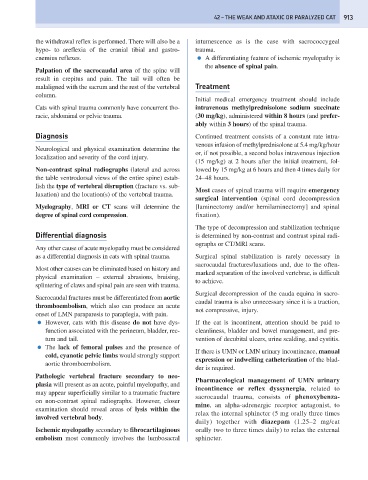Page 921 - Problem-Based Feline Medicine
P. 921
42 – THE WEAK AND ATAXIC OR PARALYZED CAT 913
the withdrawal reflex is performed. There will also be a intumescence as is the case with sacrococcygeal
hypo- to areflexia of the cranial tibial and gastro- trauma.
cnemius reflexes. ● A differentiating feature of ischemic myelopathy is
the absence of spinal pain.
Palpation of the sacrocaudal area of the spine will
result in crepitus and pain. The tail will often be
malaligned with the sacrum and the rest of the vertebral Treatment
column.
Initial medical emergency treatment should include
Cats with spinal trauma commonly have concurrent tho- intravenous methylprednisolone sodium succinate
racic, abdominal or pelvic trauma. (30 mg/kg), administered within 8 hours (and prefer-
ably within 3 hours) of the spinal trauma.
Diagnosis Continued treatment consists of a constant rate intra-
venous infusion of methylprednisolone at 5.4 mg/kg/hour
Neurological and physical examination determine the
or, if not possible, a second bolus intravenous injection
localization and severity of the cord injury.
(15 mg/kg) at 2 hours after the initial treatment, fol-
Non-contrast spinal radiographs (lateral and across lowed by 15 mg/kg at 6 hours and then 4 times daily for
the table ventrodorsal views of the entire spine) estab- 24–48 hours.
lish the type of vertebral disruption (fracture vs. sub-
Most cases of spinal trauma will require emergency
luxation) and the location(s) of the vertebral trauma.
surgical intervention (spinal cord decompression
Myelography, MRI or CT scans will determine the [laminectomy and/or hemilaminectomy] and spinal
degree of spinal cord compression. fixation).
The type of decompression and stabilization technique
Differential diagnosis is determined by non-contrast and contrast spinal radi-
ographs or CT/MRI scans.
Any other cause of acute myelopathy must be considered
as a differential diagnosis in cats with spinal trauma. Surgical spinal stabilization is rarely necessary in
sacrocaudal fractures/luxations and, due to the often-
Most other causes can be eliminated based on history and
marked separation of the involved vertebrae, is difficult
physical examination – external abrasions, bruising,
to achieve.
splintering of claws and spinal pain are seen with trauma.
Surgical decompression of the cauda equina in sacro-
Sacrocaudal fractures must be differentiated from aortic
caudal trauma is also unnecessary since it is a traction,
thromboembolism, which also can produce an acute
not compressive, injury.
onset of LMN paraparesis to paraplegia, with pain.
● However, cats with this disease do not have dys- If the cat is incontinent, attention should be paid to
function associated with the perineum, bladder, rec- cleanliness, bladder and bowel management, and pre-
tum and tail. vention of decubital ulcers, urine scalding, and cystitis.
● The lack of femoral pulses and the presence of
If there is UMN or LMN urinary incontinence, manual
cold, cyanotic pelvic limbs would strongly support
expression or indwelling catheterization of the blad-
aortic thromboembolism.
der is required.
Pathologic vertebral fracture secondary to neo-
Pharmacological management of UMN urinary
plasia will present as an acute, painful myelopathy, and
incontinence or reflex dyssynergia, related to
may appear superficially similar to a traumatic fracture
sacrocaudal trauma, consists of phenoxybenza-
on non-contrast spinal radiographs. However, closer
mine, an alpha-adrenergic receptor antagonist, to
examination should reveal areas of lysis within the
relax the internal sphincter (5 mg orally three times
involved vertebral body.
daily) together with diazepam (1.25–2 mg/cat
Ischemic myelopathy secondary to fibrocartilaginous orally two to three times daily) to relax the external
embolism most commonly involves the lumbosacral sphincter.

